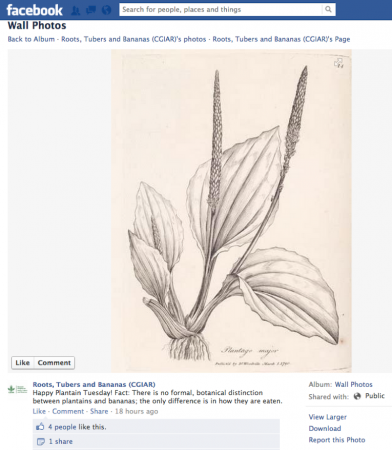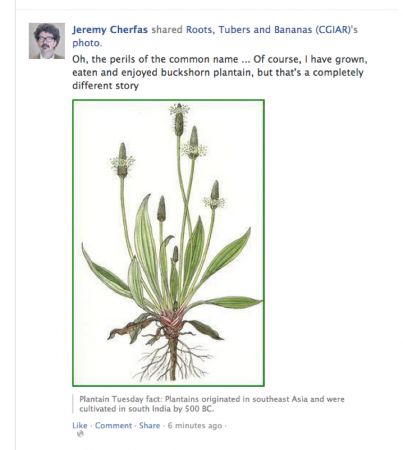- Can cultivated species get their own Red List? Stefano Padulosi asks the tough questions.
- Açaí: could the wonder fruit also be wonderful for forests? CIFOR asks the tough questions.
- And more: You mean you can eat that?
- Horticulture has rock stars? My turn to ask the tough questions.
- Ok, so what US county is “…a hotbed of diversified, small-scale organic, natural processed food production”? Maybe not so tough.
- Will there be a follow-up to Lancet’s 2008 series on malnutrition? That’s an easy one.
- Luigi’s mother-in-law asks: Where can I get my hands on that drought-resistant tea?
- Got any other questions? World Wide Views on Biodiversity wants to hear from you, this Saturday. (Answers too, I suppose.)
Brainfood: Wild soybean, Leafy vegetables collection gaps, Banana drought tolerance screening, Chinese soybean breeding, Malagasy coffee collections, Bacteria on beans
- Perennial Glycine: A new source of genetic diversity for soybean improvement. The perennial wild species are genetically and geographically distant from the crop, but at least one can be crossed, with some difficulty, and some potentially useful genes have been enticed to make their way into the cultivated genome. To no great effect, but it’s early days yet.
- Genetic resources collections of leafy vegetables (lettuce, spinach, chicory, artichoke, asparagus, lamb’s lettuce, rhubarb and rocket salad): composition and gaps. You can just read the collecting priorities for each genepool, or analyze the data yourself.
- Screening the banana biodiversity for drought tolerance: can an in vitro growth model and proteomics be used as a tool to discover tolerant varieties and understand homeostasis? Maybe.
- Development of yield and some photosynthetic characteristics during 82 years of genetic improvement of soybean genotypes in northeast China. Yield doubled, but at the cost of water use efficiency. Maybe those perennials could help?
- An assessment of the genetic integrity of ex situ germplasm collections of three endangered species of Coffea from Madagascar: implications for the management of field germplasm collections. For 3 wild species, there’s lots of genetic diversity in field genebanks, but also lots of crossing with other species.
- Diversity of culturable bacteria and occurrence of phytopathogenic species in bean seeds (Phaseolus vulgaris L.) preserved in a germplasm bank. “…the fact that potentially phytopathogenic bacteria have been preserved in a genebank should emphasize the importance of rigorous sanitary controls for plant genetic resources.” You think?
Nibbles: Heirloom conference, Saving plants, Aquaculture benefits, Ancient Egyptian botany, Coffee blogs, ITPGRFA, GIAH
- National Heirloom Exposition coming up. Any of our readers going? Oh come on, one of our readers must be going!
- Kew head honcho calls for a botanical New Deal.
- WorldFish head honcho calls for an aquacultural New Deal.
- A papyrus of recent botanical literature on ancient Egypt.
- Coffee blogs to follow. Oh gosh, am I blushing?
- Participants “gain more knowledge” at policy workshop. Of the ITPGRFA, that would be.
- A couple of Chinese agricultural systems gain recognition as Globally Important Agricultural Heritage.
When is a plantain not a plantain?
Corner a Musa-wallah over a pint of sorghum brew, and ask them to tell you the difference between a banana and a plantain. Seven will get you eleven you’ll be no wiser when they eventually finish frothing. So turn instead to the CGIAR Research Program on Roots, Tubers and Banana’s Facebook page, for true enlightenment.
Yesterday, you see, was Plantain Tuesday. So what do we learn?
That’s right! ((You may have to click on the photo to enlarge it enough to read.)) “There is in fact no formal, botanical distinction between plantains and bananas; the only difference is in how they are eaten”. So stick that in your cooking bananas, Dr Musa-wallah.
And there’s more.
“Plantains originated in southeast Asia and were cultivated in south India by 500 BC”. Triffic. What about bananas, then?
Hang on, though, I know what you’re thinking. Those two pictures don’t look much like any bananas you’ve ever seen. And you would be right about that. But hey, it’s only Facebook. Who cares whether the information is accurate?
Nibbles: Coffee, Seeds for seedlessness, Garden philosophy
- How to make coffee, diagrammed and phylogenized.
- Where do seedless watermelons come from? In a here-and-now sense.
- A long and fascinating read about gardens and war and much besides.

